初中英语说课课件全英文
- 格式:ppt
- 大小:1.36 MB
- 文档页数:25
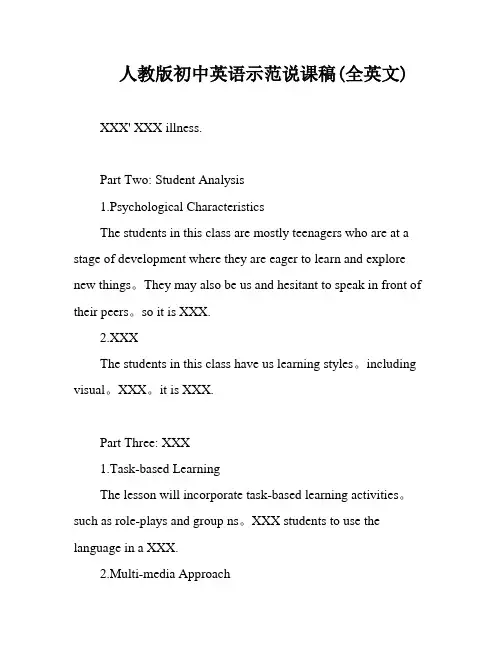
人教版初中英语示范说课稿(全英文)XXX' XXX illness.Part Two: Student Analysis1.Psychological CharacteristicsThe students in this class are mostly teenagers who are at a stage of development where they are eager to learn and explore new things。
They may also be us and hesitant to speak in front of their peers。
so it is XXX.2.XXXThe students in this class have us learning styles。
including visual。
XXX。
it is XXX.Part Three: XXX1.Task-based LearningThe lesson will incorporate task-based learning activities。
such as role-plays and group ns。
XXX students to use the language in a XXX.2.Multi-media ApproachThe use of multimedia resources。
such as videos and pictures。
XXX' XXX.Part Four: XXX1.XXXXXX students to work together and support each other in their learning.2.Self-directed LearningXXX for their own learning by setting XXX.Part XXX: res1.Warm-up ActivityThe lesson will begin with a warm-up activity。
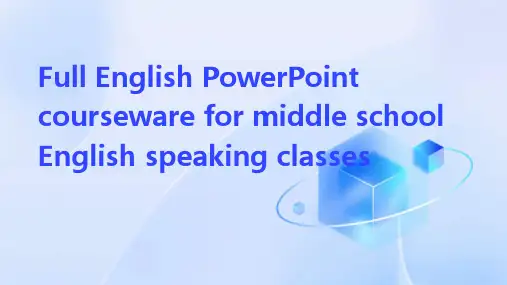

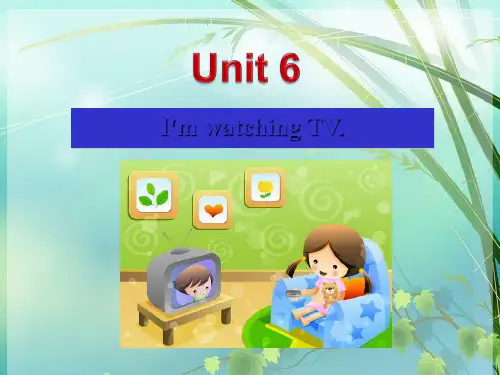

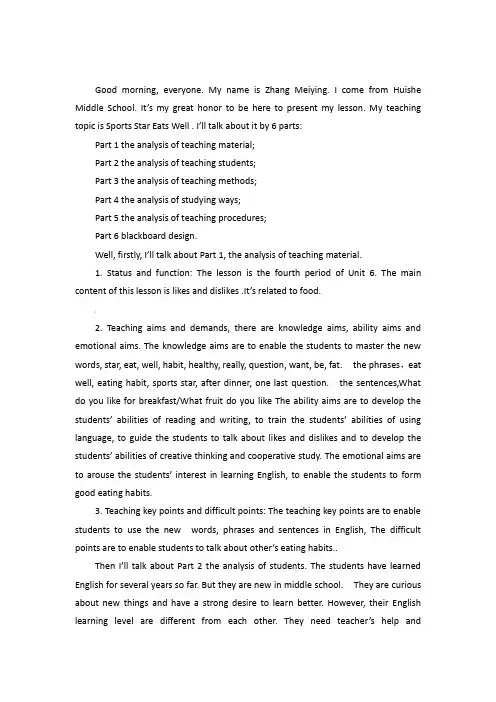
Good morning, everyone. My name is Zhang Meiying. I come from Huishe Middle School. It’s my great honor to be here to present my lesson. My teaching topic is Sports Star Eats Well . I’ll talk about it by 6 parts:Part 1 the analysis of teaching material;Part 2 the analysis of teaching students;Part 3 the analysis of teaching methods;Part 4 the analysis of studying ways;Part 5 the analysis of teaching procedures;Part 6 blackboard design.Well, firstly, I’ll talk about Part 1, the analysis of teaching material.1. Status and function: The lesson is the fourth period of Unit 6. The main content of this lesson is likes and dislikes .It’s related to food.:2. Teaching aims and demands, there are knowledge aims, ability aims and emotional aims. The knowledge aims are to enable the students to master the new words, star, eat, well, habit, healthy, really, question, want, be, fat. the phrases,eat well, eating habit, sports star, after dinner, one last question. the sentences,What do you like for breakfast/What fruit do you like The ability aims are to develop the students’abilities of reading and writing, to train the students’abilities of using language, to guide the students to talk about likes and dislikes and to develop the students’ abilities of creative thinking and cooperative study. The emotional aims are to arouse the students’ interest in learning English, to enable the students to form good eating habits.3. Teaching key points and difficult points: The teaching key points are to enable students to use the new words, phrases and sentences in English, The difficult points are to enable students to talk about other’s eating habits..Then I’ll talk about Part 2 the analysis of students. The students have learned English for several years so far. But they are new in middle school. They are curious about new things and have a strong desire to learn better. However, their English learning level are different from each other. They need teacher’s help andencouragement in their further study.Let’s move on to another part: the analysis of teaching methods. In my lesson, I will use multimedia computer assisted instruction(多媒体计算机辅助教学), task-based activities(任务型教学法), situational approach(情境教学法).Next is the studying ways. Help the students to learn to study independently, learn to cooperate with others. In class, encourage the students to communicate with others and build up their confidence.Now I’ll talk about teaching procedures. I design my lesson into five steps. First, I’ll divide the students into 12 groups and bring a competition into the class.Step 1 is Greeting and Warm-up. Free talk between Teacher and Students. Such as:Today we’re going to talk about kind of food do you like What do you like for breakfast What do your parents like for breakfast The food like milk break eggs or apple soup and so on may be appear in the student’s answers. By this, the students can be interested in it and pay their attention to our class easilyStep 2 pre-reading. Here I’ll show the new words and phrases in this article .and also explain them in Engish. By this, the students can understand the article easily.Step 3 is reading. Firstly I will ask the students to read the article and circle the food words. Then read the words all together. Secondly ,I will let them read it again and write 5 sentences about Cindy’s eating habits. Like Cindy likes healthy food./Cindy doesn’t like bananas. By this they will more familiar with the grammer of this unit .Thirdly ,they will be asked to translate 3 sentenses. What do you like for breakfast I love fruit. I think it’s you eat ice-cream after dinner I don’t want to be fat. Fourthly ,answer Cindy like chicken for breakfast 2、Dose Cindy want to eat ice-cream3、What does Cindy like for breakfast 4、What fruit does Cindy like #Step4 language points and exercises.Step 4 after readingNow the students need to write something to talk about others’likes and dislikes about food . if time is enough ,some students should show their articles.Step 5 is Summarize and homework. Here I’ll ask the students such questions:What have we learned from this lesson What new phrases have we learned today At last, tell the students what today’s homework is.Ok, that’s all. Thanks for your listening. Goodbye.。


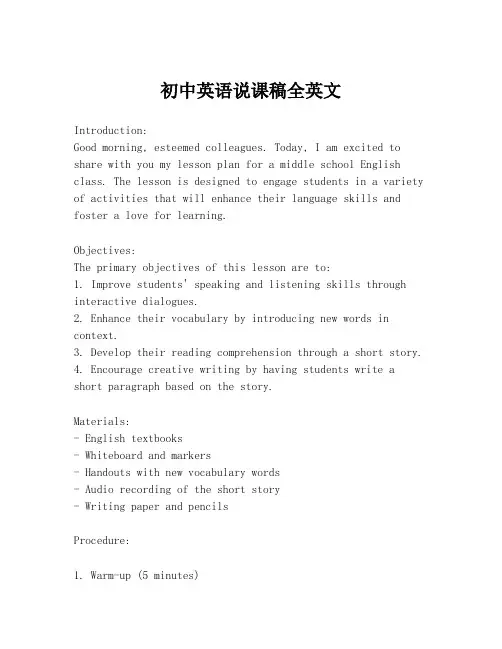
初中英语说课稿全英文Introduction:Good morning, esteemed colleagues. Today, I am excited to share with you my lesson plan for a middle school English class. The lesson is designed to engage students in a variety of activities that will enhance their language skills and foster a love for learning.Objectives:The primary objectives of this lesson are to:1. Improve students' speaking and listening skills through interactive dialogues.2. Enhance their vocabulary by introducing new words in context.3. Develop their reading comprehension through a short story.4. Encourage creative writing by having students write a short paragraph based on the story.Materials:- English textbooks- Whiteboard and markers- Handouts with new vocabulary words- Audio recording of the short story- Writing paper and pencilsProcedure:1. Warm-up (5 minutes)Begin the class with a quick warm-up activity to get students thinking in English. I will ask students to share one thing they did over the weekend, using the present perfect tense.2. Vocabulary Introduction (10 minutes)Introduce new vocabulary words that are relevant to the theme of the lesson. Use flashcards or a PowerPoint presentation to display the words along with their meanings and pronunciation. Engage students in a matching game to reinforce learning.3. Listening Comprehension (15 minutes)Play an audio recording of a short story related to the new vocabulary. Before playing the recording, provide studentswith a list of key questions to listen for. After the first listening, discuss the answers as a class.4. Reading Comprehension (20 minutes)Distribute a printed copy of the short story. Have students read it silently and then answer comprehension questions in small groups. Encourage them to use the new vocabulary wordsin their discussions.5. Speaking Activity (15 minutes)Divide the class into pairs and have them act out a dialogue based on the short story. Each pair should create their own dialogue that includes the new vocabulary words.6. Writing Activity (15 minutes)Instruct students to write a short paragraph from the perspective of one of the characters in the story. Theyshould incorporate the new vocabulary words and express thecharacter's feelings or thoughts.7. Conclusion (5 minutes)Conclude the lesson by reviewing the objectives and summarizing the key points. Ask for volunteers to share their written paragraphs, providing feedback and praise.Assessment:Students will be assessed based on their participation in class activities, their ability to use the new vocabulary correctly, and the quality of their written paragraph.Differentiation:For advanced students, provide more complex sentences to create during the speaking activity. For struggling students, offer additional support with vocabulary and sentence structure during the writing activity.Closure:Thank you for your attention. I am looking forward to implementing this lesson and observing the progress of our students in their English language journey.。

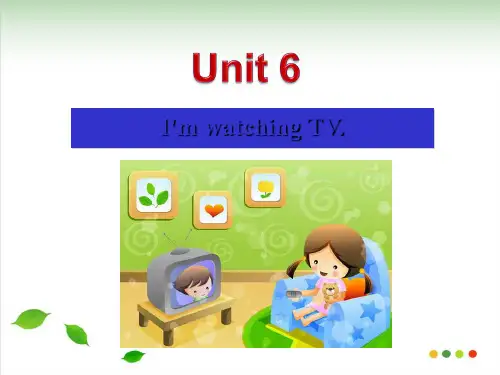
英语说课09英本5班刘婷婷ContentsAnalysis of Teaching MaterialTeaching Learning Methods Teaching ProceduresDesign of the blackboard4123Part 1 Analysis of Teaching MaterialStatus and FunctionThe article comes from Unit 1 section A 1a-2c ballbook. This is an important lesson. From this lesson, itstarts asking the Ss to grasp contents of eachSample. To attain “four skills” request of listening,speaking, reading and writing. To start listing “WordBank” and tell the Ss to remember the new words. Tostart asking the Ss to write the English sentenceswell. Therefore this lesson is in the important positionof the teaching material. Such a topic is related todaily life, so it is helpful to raise learning interests ofstudents and it will be also helpful to improve theirspoken English.(1)To enable the Ssto understandand speak: whatis your name?My name is Gina,Make sure thatSs can usethese sentencesin real situations.(2) To help Ss tofinish the wholedialogue. (1)To develop Ss’abilities oflistening andspeaking.(2)To train the Ss’ability of workingin groups.(3) To foster Ss’abilities ofcommunication .1)To foster Ss’consciousnessof good co-operation andpropercompetition.(2)To enable Ss toact naturally .(1)To help Ss learnhow to greetand askothers’names.(2)To enable Ss tostudy in groupsand co-operateskillfully.(3) To develop Ss’interest inEnglish.➢Aims on the knowledge ➢Aims on the abilities➢Aims on theemotion➢Key-points of thislesson◆Teaching aimsDescription of teaching aims❖Teaching methodsAs we all know: the main instructional aims of learningEnglish is to cultivate pupils’ basic abilities of listening and speaking and their good sense of the English language. So in this lesson I’ll mainly use “Task-based” teaching method.That is to say, I will let the Ss learn in real situations, finish a task by making a survey to help the Ss to get a betterunderstanding of the key structure of the dialogue. I willarrange four kinds of activities: singing, guessing game,finishing a survey and having a competition. And in thislesson a recorder, CAI, school things and a printed form will be needed. Students should prepare some school things.❖Learning methods①Teach the Ss how to be successful language learners.②Get the Ss to form good learning habits.③Teach the Ss how to communicate with others and takecompetition methods to develop the Ss interest in English.Warm-up andreviewPresentationHomeworkPractice and ProductionStep1Step2Step4Step3Part 3 Teaching ProceduresStep 1 Warm up and reviewWarm upfour two three four,hands on knees▪one two three four ,clap your hands ▪two two three four,stomp your feet ▪three two three four,nod your head❖Purpose:❖It is important toform a better English learning surrounding for the Ss by singing and doing some total physical response and at the same time it providessituations to review learned knowledgefor the next step.Step 2 PresentationS4Answer S3’s questions ,ask anyone in the classthe questions .S1Greeting with S2,and introduce himself and ask his name. For example :hi, my name is…what is your name ?S3Answer S2’s questions,introduce S2’s conditions and ask S4 the same questions.S2Answer S1 questions and ask S3 what is S1’s name and introduce herselfPurpose of this step❖Play the game to present the key structures one by one is much easier for the Ss to learn and grasp the meanings. Proper competition can arouse the Ss’interest in English learning❖The game can provide a real situation for the Ss to understand the dialogue and the relationshipsbetween people better. Tell the Ss we should show our loveliness to the SsStep 3 Practice and production Divide Students to 4 groups ,practice together in groupsand finally choose the best group ,give the prize.G1G2G3G4Purpose of practice and production❖Task-based teaching method is used here to develop Ss’ ability of communication and also their ability of co-operation will be well trained.❖To check the knowledge Ss have learned in this period.Step4 HomeworkRevision is so important that Ss should speak English as much as they as in class or after class. It is necessary for the Ss to do some extensive exercises after class to consolidate the knowledge they learned.Blackboard design❖New words: what, is , your ,name ,my, etc.❖The phrase: what’s your name?My name is …9英本5班刘婷婷Thank you for your appreciation !!。
完整版)初中英语说课稿全英文版Good morning。
everyone。
My name is Zhang Meiying and I am from Huishe Middle School。
I am honored to be here today to present my lesson on the topic of "Sports Star Eats Well"。
My n will be divided into six parts:Part 1: Analysis of the teaching materialPart 2: Analysis of the studentsPart 3: Analysis of the teaching methodsPart 4: Analysis of the study methodsPart 5: Analysis of the teaching resPart 6: Blackboard design.Now。
let's start with Part 1.the analysis of the teaching material.The lesson I will be discussing is the fourth d of Unit 6.which focuses on likes and dislikes related to food。
The main objectiveof this lesson is to teach students about the importance of healthy eating habits for sports stars。
To achieve this objective。
we will analyze the following aspects:1.Status and n: The lesson is an integral part of the curriculum and plays a significant role in helping students understand the importance of healthy eating habits for athletes.Let's move on to Part 2.the analysis of the students.Teaching aims and demands include knowledge aims。